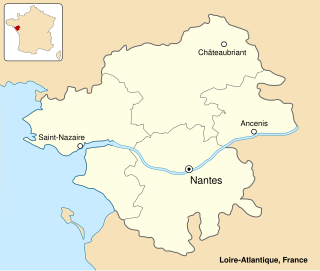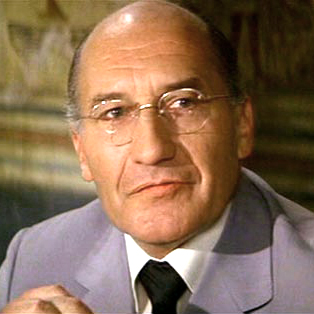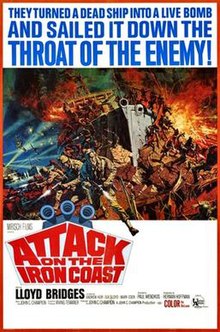
The St Nazaire Raid or Operation Chariot was a British amphibious attack on the heavily defended Normandie dry dock at St Nazaire in German-occupied France during the Second World War. The operation was undertaken by the Royal Navy (RN) and British Commandos under the auspices of Combined Operations Headquarters on 28 March 1942. St Nazaire was targeted because the loss of its dry dock would force any large German warship in need of repairs, such as Tirpitz, sister ship of Bismarck, to return to home waters by running the gauntlet of the Home Fleet of the Royal Navy and other British forces, via the English Channel or the North Sea.

The Commandos, also known as the British Commandos, were formed during the Second World War in June 1940, following a request from Winston Churchill, for special forces that could carry out raids against German-occupied Europe. Initially drawn from within the British Army from soldiers who volunteered for the Special Service Brigade, the Commandos' ranks would eventually be filled by members of all branches of the British Armed Forces and a number of foreign volunteers from German-occupied countries. By the end of the war 25,000 men had passed through the Commando course at Achnacarry. This total includes not only the British volunteers, but volunteers from Greece, France, Belgium, Netherlands, Canada, Norway, Poland, and the United States Army Rangers and US Marine Corps Raiders, Portuguese Fuzileiros Portuguese Marine Corps were modelled on the Commandos.

Operation Jubilee or the Dieppe Raid was an unsuccessful Allied amphibious attack on the German-occupied port of Dieppe in northern France, during the Second World War. Over 6,050 infantry, predominantly Canadian, supported by a regiment of tanks, were put ashore from a naval force operating under protection of Royal Air Force (RAF) fighters.

USS Buchanan (DD-131), named for Franklin Buchanan, was a Wickes-class destroyer in the United States Navy.

Peter Strasser was chief commander of German Imperial Navy Zeppelins during World War I, the main force operating bombing campaigns from 1915 to 1917. He was killed when flying the German Empire's last airship raid over the United Kingdom.

Walter Jack Gotell was a German-British actor. He was well-known for his role as General Gogol, head of the KGB, in the Roger Moore-era of the James Bond film series, as well as having played the role of Morzeny, a villain, in From Russia With Love. He also appeared as Gogol in the final part of The Living Daylights (1987), Timothy Dalton's debut Bond film.

Sergeant Thomas Frank Durrant VC was a soldier in the British Army during the Second World War and a posthumous English recipient of the Victoria Cross, the highest award for gallantry in the face of the enemy that can be awarded to British and Commonwealth forces. His award of the Victoria Cross was unique in that it is the only award given to a soldier in a naval action. It was also unusual, though not unique, in having been suggested by a German officer.

633 Squadron is a 1964 war film directed by Walter Grauman and starring Cliff Robertson, George Chakiris, and Maria Perschy. The plot, which involves the exploits of a fictional World War II British fighter-bomber squadron, was based on the 1956 novel of the same name by former Royal Air Force officer Frederick E. Smith, which itself drew on several real RAF operations. The film was produced by Cecil F. Ford for the second film of Mirisch Productions UK subsidiary Mirisch Films for United Artists. 633 Squadron was the first aviation film to be shot in colour and Panavision widescreen.

HMS Campbeltown was a Town-class destroyer of the Royal Navy during the Second World War. She was originally US destroyer USS Buchanan, and was one of 50 obsolescent U.S. Navy destroyers transferred to the Royal Navy in 1940 as part of the Destroyers for Bases Agreement. Campbeltown became one of the most famous of these ships when she was used in the St Nazaire Raid in 1942.

No. 30 Commando, from 1943 to 1946 known as 30 Assault Unit, was a British Commando unit during the Second World War, originally formed to gather intelligence.

The Guns of Navarone is a 1961 action adventure war film directed by J. Lee Thompson from a screenplay by Carl Foreman, based on Alistair MacLean's 1957 novel of the same name. Foreman also produced the film. The film stars Gregory Peck, David Niven and Anthony Quinn, along with Stanley Baker, Anthony Quayle, Irene Papas, Gia Scala, Richard Harris and James Darren. The book and the film share a plot: the efforts of an Allied commando unit to destroy a seemingly impregnable German fortress that threatens Allied naval ships in the Aegean Sea.
Operation 34A was a highly classified United States program of covert actions against the Democratic Republic of Vietnam, consisting of agent team insertions, aerial reconnaissance missions and naval sabotage operations.
MV Atheltemplar was a motor tanker built by Lithgows, Port Glasgow. She was launched on 15 April 1930, registered in Liverpool and operated by the United Molasses Co Ltd of London. She was transferred to Athel Lines on 1 January 1940.

Shayetet 13 is a unit of the Israeli Navy and one of the primary reconnaissance units of the Israel Defense Forces. Shayetet 13 specializes in sea-to-land incursions, counter-terrorism, sabotage, maritime intelligence gathering, maritime hostage rescue, and boarding. The unit is trained for sea, air and land actions. The unit has taken part in almost all of Israel's major wars, as well as other actions.
Vorpostenboot, also referred to as VP-Boats, flakships or outpost boats, were German patrol boats which served during both World Wars. They were used around coastal areas and in coastal operations, and were tasked with – among other things – coastal patrol, ship escort, and naval combat.

George Mikell was a Lithuanian-Australian actor and writer best known for his performances as Schutzstaffel (SS) officers in The Guns of Navarone (1961) and The Great Escape (1963). Mikell appeared in over 30 British and American feature films and had numerous leading roles in theatre.

Casablanca Express is a 1989 Italian action war film starring Jason Connery and Francisco Quinn that was filmed in Morocco. It was produced by Pietro Innocenzi and Umberto Innocenzi and directed by Sergio Martino. The film was later featured in an episode of Cinema Insomnia.

Hell Boats is a 1970 Technicolor British war film directed by Paul Wendkos that was filmed in Malta. It stars James Franciscus, Elizabeth Shepherd, and Ronald Allen in a story about British Motor Torpedo Boats in the Mediterranean in World War II. It was the last film made by Oakmont Productions, a branch of Mirisch Films. The film's technical advisor was Lieutenant Commander Ian Nagle Douglas Cox, who was awarded the Distinguished Service Order while serving in HMS Malcolm in 1940.
Operation Tarbrush was the name of a series of British Commando raids during the Second World War, which took place in 1944. Members of No. 10 (Inter-Allied) Commando were responsible for this operation, which was intended to obtain photographs and other evidence of mines and other traps.
MS Gruziya was one of six Soviet Krim-class ocean liners during the late 1920s built for the Black Sea State Shipping Company. During the Second World War, she participated in the Siege of Odessa in 1941 and the Siege of Sevastopol in 1942. The ship was sunk by a German bomber en route to the latter port in June; there were no survivors.















